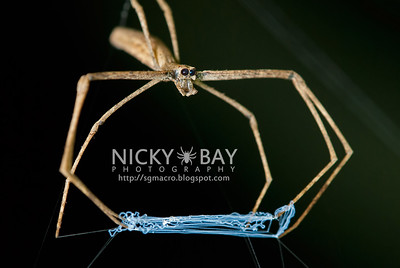SPIDER OF INTEREST
Welcome to Spider of Interest, also known as S.O.I., where I write a little blurb about a particular spider I recently learned about or find interesting. These are updated as I find the time and motivation to write more, enjoy!

ISOPOD EATER 2/18/2023

Hello beautiful! There's a good reason Dysderidae here has such large and lovely chelicerae, they aren't regularly refered to as "Woodlouse spiders" for nothing.
While the average arachnid can have some trouble piercing the armor of an isopod, millipede, or centipede, Dysderidae has already finished it's meal. Their fangs are so impressive that these spiders will become
dominant predators against larger spiders. They can become quite the hardy fighter, especially against male counterparts.
You'll find these gems scouring dark, warm places. Taking to ground hunting rather than web building. Under logs, rocks, leaf litter, and anywhere else you might find delicious pillbugs... yes, in your home too.
Despite their menacing mouthpieces, Dysderidae pose no threat to humans other than a good pinch.
They do pose nicely for the camera, though!
In my personal opinion, the most vibrant, colorful spider just can't beat the lovely amber cephalothorax of this potatoe bug hunter... roly polie hunter? Doodle bugs. Wood pigs. Cheeselogs? Whatever, Dysderidae eats granny greys cause they're pretty much everywhere.

OGRES AND NETS 2/6/2023
The family Deinopidae is host to some of the most interesting arachnids
in the world. Common names adopted by these spiders include
"ogre faced spiders", "net-casting spiders", and "gladiator spiders."
Lately these guys have gotten a bit more popular after the release of a
Deinopidae inspired pokemon by the name of "spidops."

In my opinion, everything about these spiders is cool,
there is always something strange and new to learn about them...
so let's just jump right into it.
Unlike the rest of their arachnid brothers and sisters,
Deinopidae fashions itself a net and watches out for passing prey to then
spring out and capture them. They even use drops of faecal matter to create
a "target" on the ground below them making them an excellent (and creative?)
hunter.
Speaking of "watching," these spiders have massive posterior median eyes that
excede the nightvision of cats and even owls. Unforunately, A large portion of
membrane within the eye is so sensitive it burns away in the day and has to regrow
as night falls.
Did I mention they can "hear" sounds up to 2 meters away using sensitive hairs along
their legs?

WELCOME BACK STEATODA 1/25/2023

Welcome back to SOI, if you were around when I first started making these little
spotlights you'll probably recognize the genus Steatoda. Mortem's personal favorite
spider only rivaled by the famous Black Widow. I have several of these little beauties
(specifically S. grossa) under my care and they have been nothing but fun.
The common names associated with these guys usually relate to their aformentioned
cousin Latrodectus. With the same build and the occassional dark coloration it's no
suprise these guys are known as "False widows."
To be honest there's nothing too special about Steatoda, they are pretty common
worldwide (and under my furniture), don't have any striking coloration, and their
bites aren't all that significant... However, I just think they are so charming and
that's more than enough for them to be special.
Have a look into the dark corners of your home and find something extraordinary within
the ordinary.



